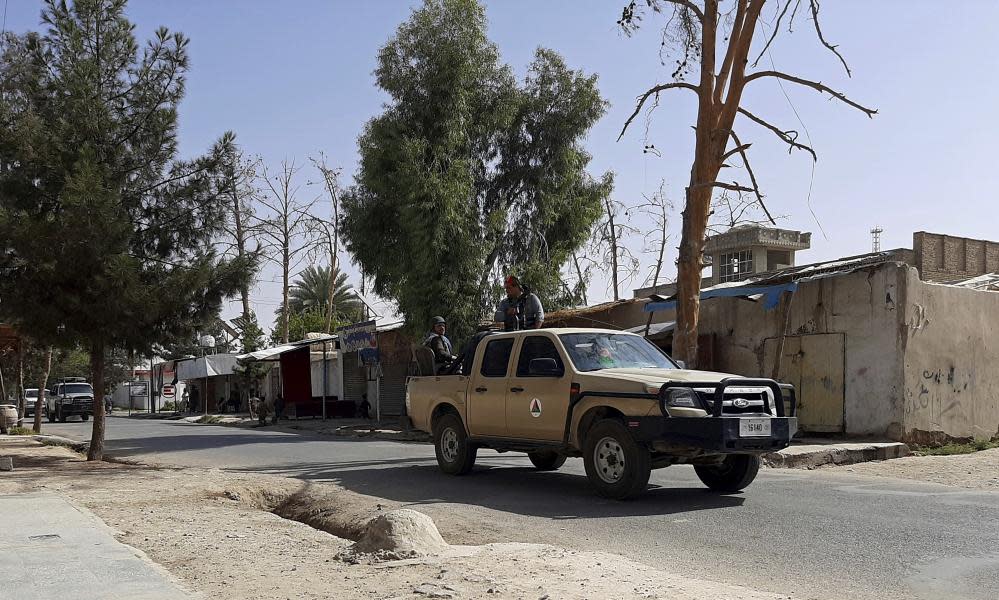Taliban on brink of taking key Afghan city as residents told to flee

Taliban fighters appeared to be on the brink of overrunning the key Afghan provincial capital of Lashkar Gah, as officials confirmed all but one district of the city was under the hardline Islamists’ control and residents were ordered to evacuate.
Majid Akhund, the deputy chairman of the Helmand provincial council, said the Taliban had taken control of nine Lashkar Gah districts, as the Afghan government and US aircraft pounded their positions with strikes.
Gen Sami Sadat, an Afghan commander leading the military efforts in Helmand, told residents to flee. “Please leave as soon as possible so that we can start our operation,” he said in a message to the city of 200,000 people.
“I know it is very difficult for you to leave your houses – it is hard for us too – but if you are displaced for a few days, please forgive us. We are fighting the Taliban wherever they are ... We will not leave a single Taliban alive.”
The Taliban advances came as the Afghan president, Ashraf Ghani, blamed the hasty withdrawal of US and Nato troops for the deteriorating security situation across the country.
The heaviest fighting in Lashkar Gah was reported around the main government compound, the prison – where an attempt to free prisoners was repulsed – and headquarters of the police and intelligence agency, with one official suggesting hundreds of soldiers had surrendered.
At least 40 civilians were reported killed and more than 100 wounded in the last 24 hours in the city.
Lashkar Gah is one of three provincial capitals under siege by the Taliban as they stepped up their onslaught against government forces.
Fida Mohammad, a tribal elder, told the Guardian: “The situation is appalling. The Taliban are climbing all the high-rise buildings in the centre of the city and setting up fortifications, then being bombed by the government.”
A resident of Lashkar Gah told Agence France-Presse on condition of anonymity: “The Taliban are everywhere in the city, you can see them on motorcycles in the streets. They are arresting or shooting people who have smartphones.
“The Taliban are in the people’s houses and the government is bombing them. About 20 houses in my neighbourhood have been bombed, they are fighting street-to-street battles.”
The loss of Lashkar Gah would be a massive strategic and psychological blow for the government, which has pledged to defend cities at all costs after losing much of the rural countryside to the Taliban over the summer.
Speaking in Washington, the US special envoy said that after their military gains, the Taliban were now demanding “the lion’s share of power” in the country’s next government. Zalmay Khalilzad repeated Washington’s call for a negotiated peace accord, saying on Tuesday that the last 40 years of conflict in Afghanistan “has no legitimacy any more.”
The continued contest for Helmand’s main city, for years a focus of US and British military operations, came as government forces appeared to have pushed the Taliban out of several areas in the economically important western city of Herat following the recent arrival of hundreds of commando reinforcements.
While the Taliban’s countrywide offensive has targeted three provincial capitals, including Kandahar and Herat, the attempt to take Lashkar Gah has emerged for now as the key battle in the group’s ambitions to take and hold a provincial capital in the hope it will topple the surrounding provinces.
In recent days, the US military has intensified airstrikes across the country in an attempt to stem Taliban progress, not least in Lashkar Gah, after a week of rapid advances.
The Taliban has seized control of much of rural Afghanistan since foreign forces began the last stage of their withdrawal in early May, but are meeting resistance as they try to take provincial capitals.
Although most US and other foreign ground forces have withdrawn, the US has confirmed it has launched airstrikes to support the Afghan military. While some have been drone strikes, reports have also suggested that US B-52 bombers – probably from the Al Udeid airbase in Qatar – have also flown in support.
The continuing violence in Helmand came as the United Nations warned that “indiscriminate” gunfire and airstrikes were hurting civilians the most.
Late on Friday, a massive blast rocked the Afghan capital, Kabul, as the residence of the defence minister, Bismillah Khan Mohammadi, was targeted by a car bomb. The minister was not present and his family was safely evacuated, according to officials.Fighting also continued elsewhere in Afghanistan, including around Kandahar and in the economically important western city of Herat, where there were clashes close to the city centre on Tuesday.
In Herat, Afghan officials said government forces had managed to push back the insurgents from several areas of the city – including near the airport. But later on Tuesday intense gunfire continued in south and western parts of the city and its outskirts as more civilians fled their homes.
Afghan defence and security forces – along with armed men loyal to Ismail Khan, a septuagenarian veteran of several iterations of civil war in Afghanistan – were fighting with Taliban insurgents on at least two frontlines, both less than 10-minute drive away from the centre of Herat.
Residents in the western neighbourhood of Hawz e Karbas described Taliban fighters taking over civilian houses. “They knocked our door overnight and forced their way up to our roof,” a resident of the area said after fleeing downtown.
“We left everything behind and fled. They are currently fighting from our home. I don’t know if anything remains from my property.”

 Yahoo Movies
Yahoo Movies 
